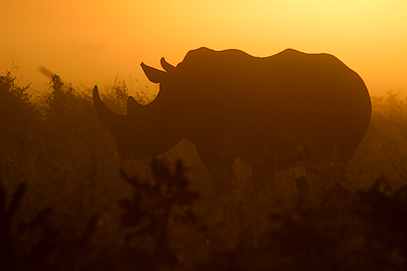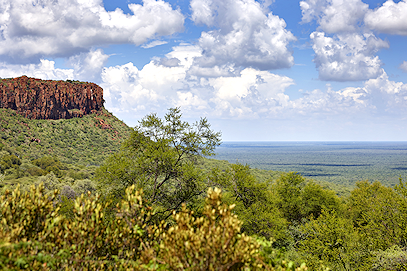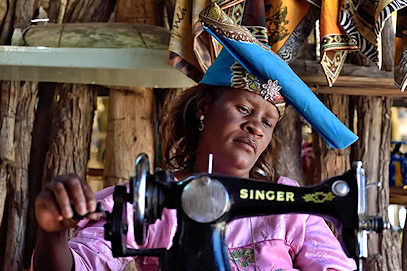The Waterberg Plateau Park is one of Namibia's most scenic and wildlife-rich areas. Antelope species that thrive here include eland, roan antelope, tsessebe, and sable antelope. If you aren't after ticking dangerous game species or predators off your list, you'll enjoy the unique offerings of the Waterberg Plateau.
Need Advice?The park's most significant feature is the 50km long and 16km wide "table mountain," rising from the plains to a height of up to 200 meters. The views from the top are truly spectacular.

Geologically, the oldest rock stratum is over 850 million years old, and dinosaur tracks were left there some 200 million years ago. The area is historically significant in terms of both ancient and recent history, hosting San rock art engravings and the graves of those that perished in the Battle of the Waterberg. Hiking trails, rhino tracking, cultural tours, game drives, and history walks make up the park's engaging safari activities.
Elephants, rhinos, giraffes, small carnivores, and several antelope and bird species grace the park. Kudu, eland, roan, sable, springbok, gemsbok, red hartebeest, and smaller antelope inhabit the Waterberg Plateau Park. Once abundant, Cape Vultures are now scarce and one of the park's main attractions. Game drives are guided and take place bi-daily.
Guests can take a few guided hiking tours around the area to appreciate the scenery and wilderness around them. One of these hikes takes you to the top of the plateau with amazing views of the park and surrounding areas. There are also nine unguided hiking trails, including a 42km adventure.
With around 500 species of flora in the park, the Waterberg Plateau is renowned for its diversity. A whopping 74 species of grasses occur in this area. Sixty-nine tree species have been identified, while 139 are recorded in the region beyond the park's borders. If the finer details of nature fascinate you, you will find a visit to the Waterberg Plateau particularly rewarding.
The Waterberg Plateau's unique combination of historical intrigue, bountiful wildlife, and striking geology lends itself to unforgettable experiences. Relish the diversity and the off-the-beaten-track nature of this hidden gem.



By air, your journey from your home country to Johannesburg or Cape Town International Airport is followed by a regional flight to Windhoek’s Hosea Kutako International Airport. Once you have set foot in the capital of Namibia, you can either take a short charter flight to the Waterberg Plateau Park or take your journey to the road. Most tours will include this charter flight for convenience purposes, and it is the recommended choice of transport to the park.
Your drive from the capital, Windhoek, will be in a large, comfortable vehicle for around four hours. If you went with the recommended charter flight option, the drive would only be a few minutes from the airstrip to your camp or lodge.
June to October is the best time to visit the park. The area is reasonably hot year-round, but the summer heat between January and March might be too much for some. April and May are a bit cooler, but the winter and early spring months are the best time because of the drier, more temperate conditions that are better for game viewing and are more bearable. In these months, like most drier regions, animals gather around waterholes and dams for water because it is scarcer, as opposed to summer when rains make water more accessible and scattered around bush areas. Nonetheless, you will find an abundant range of animal life year-round here, although the winter months are a better option for visiting.
The area is ancient, even among the rest of the archaic region today referred to as Namibia. Many fossils and signs of ancient life have been excavated here, with some of the rocks dating back nearly 850 million years, before most life on earth today. Dinosaur footprints or tracks have also been unearthed here on more than one occasion, with carbon-dating reporting that these reptilian beasts roamed the area around 200 million years ago during the early stages of the Jurassic period. In more recent history, the site has become home to the tribes of the local Herero people until their attempted extermination by German colonial forces in the infamous battle of Waterberg in 1904. Very few Herero descendants are still alive, none of which are in the region.
The park is rich in biodiversity, with many animal and bird species. Antelopes like the eland, kudu, red hartebeest, klipspringer and rare Damara dik-dik are found within the park. Klipspringers are found on the foothills of the Waterberg Plateau, where the area's leopards often hunt them. Furthermore, in the region, you can also find hyenas, jackals, and small feline carnivores like caracals and cheetahs. Baboons are occasionally observed sitting on rocks and socializing. Rhinos and elephants are also residents here, and giraffes can often be seen browsing on the tops of the many thorn tree species that are found in this relatively arid region.
The plateau, standing out among the flatness of the Kalahari and the semidesert areas surrounding it, resembles Table Mountain in the sense that the plateau is virtually a vertical shift of the region surrounding it. The rocky cliffs are full of quick-footed antelope and smaller, herbivorous animals, while the usual plains game grazes upon the arid Kalahari flats, upon which the cliffs look down. Many interesting plants and trees grow on the hills, and some root themselves into the rock. The Waterberg is lush and green compared to the surrounding area, especially the region to the East going into the Kalahari.
You can go hiking on the walking trails up the cliffs or between its foothills. These trails are guided by professional rangers based at the camps in the area - an educational and adventurous exploration of the area, its history, and wildlife. The area's colonial and geological histories are among the many attractions one can explore. Guests seeking less strenuous activities always have game drives and breathtaking scenery to take in and admire. The game drives are also guided and done from the comfort of a shaded, touring vehicle.